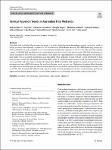Thông tin tài liệu
Thông tin siêu dữ liệu biểu ghi
| Trường DC | Giá trị | Ngôn ngữ |
|---|---|---|
| dc.contributor.author | Saintilan, Neil | - |
| dc.contributor.author | Sun, Yujie | - |
| dc.contributor.author | Lovelock, Catherine E. | - |
| dc.date.accessioned | 2023-10-03T08:16:41Z | - |
| dc.date.available | 2023-10-03T08:16:41Z | - |
| dc.date.issued | 2023 | - |
| dc.identifier.uri | https://link.springer.com/article/10.1007/s12237-023-01267-x | - |
| dc.identifier.uri | https://dlib.phenikaa-uni.edu.vn/handle/PNK/9432 | - |
| dc.description | CC-BY | vi |
| dc.description.abstract | Australian tidal wetlands differ in important respects to better studied northern hemisphere systems, an artefact stable to falling sea levels over millennia. A network of Surface Elevation Table-Marker Horizon (SET-MH) monitoring stations has been established across the continent to assess accretionary and elevation responses to sea-level rise. This network currently consists of 289 SET-MH installations across all mainland Australian coastal states and territories. SET-MH installations are mostly in mangrove forests but also cover a range of tidal marsh and supratidal forest ecosystems. Mangroves were found to have higher rates of accretion and elevation gain than all the other categories of tidal wetland, a result attributable to their lower position within the tidal frame (promoting higher rates of accretion) higher biomass (with potentially higher rates of root growth), and lower rates of organic decomposition. | vi |
| dc.language.iso | en | vi |
| dc.publisher | Springer | vi |
| dc.subject | SET-MH | vi |
| dc.subject | Australian Tidal Wetlands | vi |
| dc.title | Vertical Accretion Trends in Australian Tidal Wetlands | vi |
| dc.type | Book | vi |
| Bộ sưu tập | ||
| OER - Khoa học môi trường | ||
Danh sách tệp tin đính kèm:

